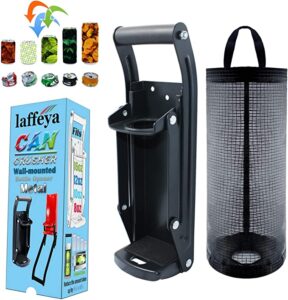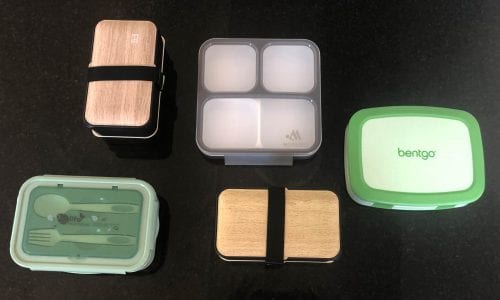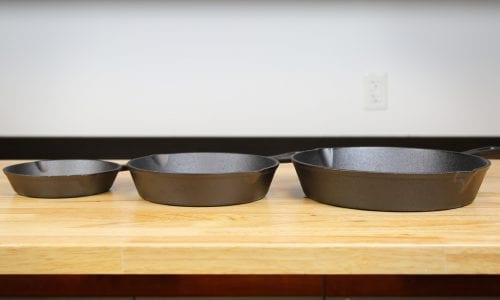The Best Can Crushers for Saving Space in Your Recycling Bin

Our Review Process
Don't Waste Your Money is focused on helping you make the best purchasing decision. Our team of experts spends hundreds of hours analyzing, testing, and researching products so you don't have to. Learn more.
Our Picks For The Top Can Crushers
- 1. McKay Heavy Duty Wall Mounted Metal Can Crusher
- 2. Pardecor Heavy Duty Wall Mounted Metal Can Crusher
- 3. HomeBuddy Wall Mounted Rubber-Lined Aluminum Can Crusher
- 4. Dial Industries Easy Pull Wall Mounted Aluminum Can Crusher
- 5. ATTEC Heavy Duty Pneumatic Aluminum Can Crusher
- 6. DALAO Heavy Duty Wall Mounted Aluminum Can Crusher
- 7. BEBEBAO MasterCrush Wall Mounted Aluminum Can Crusher
- 8. laffeya Eco-Friendly Wall Mounted Aluminum Can Crusher
- 9. Chambridge Heavy-Duty Wall-Mounted Aluminum Can Crusher
Designed to crush 12-ounce aluminum cans, this crusher is both durable and attractive. It comes in a variety of color options, including white, to help you match your décor. You'll get all the hardware necessary to mount it to any surface, including a wall, table or countertop.
Multiple Color OptionsThis can crusher comes in a variety of colors to help you find the right match for your space.
Thick steel metal gives this can crusher durability and strength. It includes a built-in bottle opener and can handle all 12-ounce to 16-ounce aluminum cans and plastic bottles. A cushioned grip handle keeps your hand comfortable while you use it.
Extra UsefulWith a built-in bottle opener, this can crusher provides two features in one.
Tackle can crushing in bulk with this crusher, which has a cushioned hand and wider handle to keep you comfortable while you're crushing. It features thick sheet steel, with reinforced rivets and bolts giving the handle durability. The base is lined in rubber to hold cans in place throughout the crushing process.
Extra StabilityThick sheet steel and reinforced bolts give you plenty of stability as you’re crushing cans.
This can crusher features a patented pivoting mechanism that makes crushing cans a breeze. The design also keeps fingers safe while you're using it. Mount it directly above your trash can and let the cans fall, keeping your hands clean while you crush.
Understated ClassThe streamlined design of this can crusher makes it blend easily with any environment.
Buying Guide
Do you recycle your aluminum cans? If so, you aren’t alone. In fact, aluminum cans are the most recycled of all consumer products.
But getting those materials into your recycle bin can be tough. First, there’s the fact that recycling centers request that you empty out all liquid before tossing them in the bin. Then, you have to deal with cans filling up that bin, particularly if you go through quite a few cans between recycling pickups.
That’s where a can crusher can help. These tools feature a handle that you use to reduce a 12- or 16-ounce can to 20 to 25 percent of its original size. Since aluminum cans are fairly pliable, most of these crushers are manually operated. Insert the can, pull a handle to crush and discard.
Most can crushers are built to be mounted. The idea is that you install them on a wall or counter above a recycle container. Once the can is crushed, it drops into the bin below. Your fingers won’t even have to come into direct contact with the can, which can be fairly sticky once crushing is complete.
Before you buy a can crusher, you’ll first need to assess your surroundings and decide where you’ll mount it. Then choose a crusher that can squeeze into that space. Pay particular attention to the mounting surface. Some surfaces might require you to use an adhesive, but many others will allow you to mount them with a screw or nail.
Can crushers aren’t just for sodas, though. You can use them for beers and seltzers, as well as more lightweight juice cans. Some cans are thicker, making them too tough for most can crushers. Those will have to be recycled uncrushed.
What to Look For
- Before you order your can crusher, check to see if it comes with the necessary mounting hardware. You may need to purchase screws or nails ahead of time. Even if your chosen crusher does come with hardware, though, you’ll still need the appropriate tools.
- Take a good look at the construction of any can crusher. The more durable the materials, the easier the crushing process will be. You’ll also want to make sure the handle is secured with reinforced bolts.
- Some can crushers have handles that are cushioned to keep your hand comfortable while you’re using them. This can reduce hand fatigue, making it especially important if you plan to crush dozens of cans at once.
- Can crushers can come in handy if you routinely have outdoor parties that generate a large number of empty cans. You could hang the crusher on a post near a trash can and let your guests do the crushing.
- Although you’ll find plenty of neutral-toned can crushers, some come in vivid colors that can be a complement to your existing décor.
- You can find multipurpose can crushers, such as those with built-in bottle openers. This can help save space and eliminate the need to purchase separate tools for the purpose.
- Some can crushers are built solely to crush 12-ounce cans. If you regularly have 16-ounce cans, you’ll want to look for a crusher that can handle both sizes.
- Extra stability can come in handy while you’re crushing. Some have rubber bases that ensure the can doesn’t slip while you’re crushing.
- Safety is important while crushing cans. If you hang your can crusher where children can reach it, opt for one with safeguards built in to keep little fingers safe.
- If you’re crushing cans, you’ll want to make sure you empty them completely before crushing them. Otherwise, you could find that the liquid sprays everything nearby.
More to Explore
Although aluminum was not discovered for use as a metal until the 1800s, the use of aluminum has been traced all the way back to Ancient Greece. Aluminum as a chemical compound was used as a dye in clothing. An aluminum-based salt called alum was the chemical used for this. A commander discovered that when treated with alum, wood was flame-resistant, so he used it to protect his wooden forts against attack by fire.
Starting in 16th-century Europe, alum was used for tanning, as well as for paper sizing in the print industry. It was also used in medicine.
In the 1800s, scientists began working with aluminum alloys for experiments. A German chemist worked with aluminum powder in the early 1800s, and over the course of 18 years, he was able to finally create balls of solidified aluminum. From there, scientists were able to find new uses for aluminum as a metal.



















